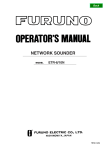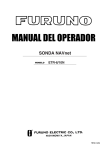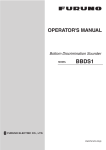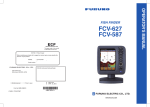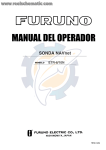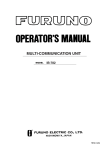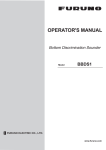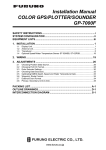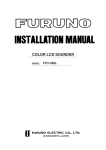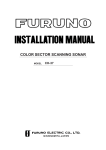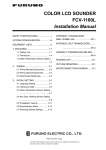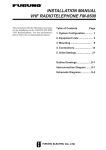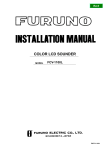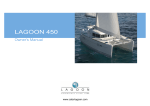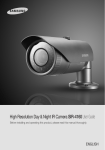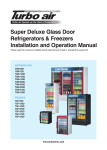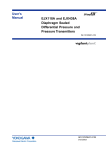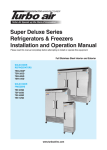Download external equipment setup
Transcript
C Yo u r L o c a l A g e n t/D e a le r 9-52, A shihara-cho, N ishinom iya, Japan Te l e p h o n e : Te l e f a x : 0 7 9 8 -6 5 -2 111 0798-65-4200 A ll rig h ts re s e rv e d . Printed in Japan PU B. N o. IM E-23620-J (H IM A ) FCV-600L FIRST EDITIO N J : : FEB. O C T. 1998 19, 2001 SAFETY INSTRUCTIONS CAUTION WARNING Ground the equipment to prevent mutual interference. Do not open the cover unless totally familiar with electrical circuits and service manual. Improper handling can result in electrical shock. Observe the following compass safe distances: Turn off the power at the switchboard before beginning the installation. Display Unit Fire or electrical shock can result if the power is left on. Standard Steering 0.8m 0.6m When handling the transducer cable, keep in mind the following points. . Keep the cable away from oil and fuel. . Keep the cable away from the place where it may be damaged during the installation. . Do not paint the cable. Do not install the equipment where it may get wet from rain or water splash. Water in the equipment can result in fire, electrical shock or equipment damage. Be sure no water leaks in at the transducer installation site. Water leakage can sink the vessel. Also confirm that the transducer will not loosen by ship's vibration. The installer of the equipment is solely responsible for the proper installation of the equipment. FURUNO will assume no responsibility for any damage associated with improper installation. The sheath of the transducer cable is made of chlorophrene rubber (or vinyl chloride). Therefore, do not paint the sheath with organic liquid (such as toluene) since it may harm the sheath. Be sure that the power supply is compatible with the voltage rating of the equipment. Connection of an incorrect power supply can cause fire or equipment damage. The voltage rating of the equipment appears on the label above the power connector. i i TABLE OF CONTENTS EQUIPMENT LISTS ............................................................................................. iii SYSTEM CONFIGURATION ................................................................................ iv MOUNTING 1.1 Display Unit..................................................................................................................... 1 1.2 Thru-hull Mount Transducer 520-5PSD, 520-5MSD ........................................................ 3 1.3 Transom Mount Transducer 520-5PWD, Optional Transom Mount Triducer 520ST-PWD ............................................................ 6 1.4 Inside-hull Mount Transducer 520-5PSD, 520-5MSD...................................................... 8 1.5 Optional Water Temperature/Speed Sensors .................................................................11 1.6 Optional Water Temperature Sensors ........................................................................... 12 1.7 Optional Triducer 524ST-MSD, 525ST-MSD ................................................................. 14 WIRING 2.1 Wiring ........................................................................................................................... 15 2.2 Connection of Optional Sensors.................................................................................... 17 2.3 Optional 50 kHz and 200 kHz Transducers ................................................................... 19 EXTERNAL EQUIPMENT SETUP 3.1 External Equipment Setup ............................................................................................ 19 APPENDIX TRIDUCER 525ST-PWC/PWD ....................................................AP-1 PACKING LIST .................................................................................................. A-1 OUTLINE DRAWINGS ...................................................................................... D-1 INTERCONNECTION DIAGRAM...................................................................... S-1 SCHEMATIC DIAGRAMS ................................................................................. S-2 ii EQUIPMENT LISTS Standard Supply No. Name Type Code No. Qty 1 Display Unit CV-600L 2 Installation Materials CP02-06000 000-015-398 1 set 3 Spare Parts SP02-03800 004-399-110 1 set 520-5PSD 000-015-125 520-5MSD 000-015-127 520-5PWD 000-015-126 4 Transducer Remarks 1 Includes power cable Inside-hull Select Inside-hull, w/8 m cable one Transom mount, w/8 m cable Optional Supply No. Name 1 Rectifier 2 Cable Assy. 3 Cable Assy. 4 5 Triducer Temperature Sensor Type Code No. Remarks MJ-A6SPF0012-050 000-134-424 6P-6P, 5 m MJ-A6SPF0012-100 000-133-817 6P-6P, 10 m MJ-A6SPF0011-050 000-132-244 6P-4P, 5 m MJ-A6SPF0011-100 000-132-336 6P-4P, 10 m 524ST-MSD 000-015-224 525ST-MSD 000-015-263 520ST-PWD 000-015-128 525ST-PWD 000-015-261 T-02MTB 000-040-026 With 8 m cable, transom mount T-02MSB 000-040-040 Thru-hull type T-03MSB 000-040-027 With 8 m cable, thru-hull type ST-02MSB 000-137-986 Thru-hull type ST-02PSB 000-137-987 With 8 m cable, thru-hull type PR-62 6 ST Sensor 7 Inside Hull Kit S 22S0191-0 000-802-598 8 Converter Connector 02S4093 000-134-901 Transducer of AIRMAR CORP. 9 Converter Connector 02S4147 000-141-082 Water temperature/speed sensor 10 Converter Connector 02S4167 000-142-503 Extends standard transducer cable 10m. iii SYSTEM CONFIGURATION DISPLAY UNIT CV-600L Ship’s mains 12-24 VDC TRANSDUCER Standard supply 520-5PSD 520-5MSD 520-5PWD Optional supply (triducer) 524ST-MSD 520ST-PWD External equipment (GPS navigator, etc.) SPEED, TEMPERATURE SENSOR (option) Speed/temperature sensor ST-02MSB ST-02PSB Temperature sensor T-02MTB T-02MSB T-03MSB iv MOUNTING 1.1 Display Unit Mounting considerations The display unit can be installed on a tabletop or on the overhead. When selecting a mounting location for the display unit keep the following in mind: • Keep the display unit out of direct sunlight. • The temperature and humidity should be moderate and stable. • Locate the unit away from exhaust pipes and vents. • The mounting location should be well ventilated. • Mount the unit where shock and vibration are minimal. • Keep the unit away from electromagnetic field-generating equipment such as motors and generators. • For maintenance and checking purposes, leave sufficient space at the sides and rear of the unit and leave slack in cables. • A magnetcompass will be affected if placed too close to the display unit. Observe the following compass safe distances to prevent disturbance to the magnetcompass: Standard compass: 0.8 meters Steering compass: 0.6 meters Cover Tabletop Overhead Figure 1-1 Display unit mounting methods 1 Removing cover While pressing the center of the cover with your thumbs as illustrated, pull the cover towards you to remove it. Mounting procedure Figure 1-2 How to set the display unit to the hanger 2 1.2 Thru-hull Mount Transducer 520-5PSD, 520-5MSD Transducer mounting location This type of mounting provides the best performance of all, since the transducer protrudes from the hull and the effect of air bubbles and turbulence near the hull skin is reduced. When the boat has a keel, the transducer should be at least 30 cm away from it. Typical thru-hull mountings are shown in the figure on the next page. The performance of this sounder is directly related to the mounting location of the transducer, especially for high-speed cruising. The installation should be planned in advance, keeping the standard cable length (8 m) and the following factors in mind: • Air bubbles and turbulence caused by movement of the boat seriously degrade the sounding capability of the transducer. The transducer should, therefore, be located in a position where water flow is the smoothest. Noise from the propellers also adversely affects performance and the transducer should not be mounted nearby. The lifting strakes are notorious for creating acoustic noise, and these must be avoided by keeping the transducer inboard of them. • The transducer must always remain submerged, even when the boat is rolling, pitching or up on a plane at high speed. • A practical choice would be somewhere between 1/3 and 1/2 of the boat’s length from the stern. For planing hulls, a practical location is generally rather far astern, so that the transducer is always in water regardless of the planing attitude. Transducer outline drawings 22 24 120 120 30 All dimensions 28 in millimeters Ship's bow 68 68 520-5PSD 87 520-5MSD Figure 1-3 Dimensions of transducers 520-5PSD, 520-5MSD 3 Acceptable transducer mounting locations Deep-V hull • Position 1/2 to 1/3 length of the hull from stern • 15 to 30 cm off center line (inside first lifting strakes). Figure 1-4 Transducer mounting location on deep-V hull High speed V-planing hull • Within the wetted bottom area • Deadrise angle within 15° Figure 1-5 Transducer mounting location on high speed V-planing hull Typical thru-hull mount transducer installations Fairing block Flat washer Rubber washer Hull bottom Hull bottom Deep-V Hull Flat Hull Figure 1-6 Typical thru-hull mount transducer installations 4 Procedure for installing the thru-hull mount transducer 1. With the boat hauled out of the water, mark the location selected for mounting the transducer on the bottom of the hull. 2. If the hull is not level within 15° in any direction, fairing blocks made out of teak should be used between the transducer and hull, both inside and outside, to keep the transducer face parallel with the water line. Fabricate the fairing block as shown below and make the entire surface as smooth as possible to provide an undisturbed flow of water around the transducer. The fairing block should be smaller than the transducer itself to provide a channel to divert turbulent water around the sides of the transducer rather than over its face. Hole for stuffing tube BOW Upper half Lower half Saw along slope of hull. Figure 1-7 Construction of fairing block 3. Drill a hole just large enough to pass the threaded stuffing tube of the transducer through the hull, making sure it is drilled vertically. 4. Apply a sufficient amount of high quality caulking compound to the top surface of the transducer, around the threads of the stuffing tube and inside the mounting hole (and fairing blocks if used) to ensure watertight mounting. 5. Mount the transducer and fairing blocks and tighten the locking nuts. Be sure that the transducer is properly oriented and its working face is parallel to the waterline. Note: Do not over-stress the stuffing tube and locking nuts through excessive tightening, since the wood block will swell when the boat is placed in the water. It is suggested that the nut be tightened lightly at installation and retightened several days after the boat has been launched. 5 1.3 Transom Mount Transducer 520-5PWD, Optional Transom Mount Triducer 520ST-PWD This type of mounting is very commonly employed, usually on relatively small I/O or outboard boats. Do not use this method on an inboard motor boat because turbulence is created by the propeller ahead of the transducer. There are two methods of installation: flush with hull (for flat hulls) and projecting from hull (for deep V-hulls). D D>50 cm Flat Hull Deep V-hull Figure 1-8 Transom mount transducer mounting locations Installing the transom mount transducer flush with hull (for flat hulls) A suitable mounting location is at least 50 cm away from the engine and where the water flow is smooth. 1. Drill four pilot holes in the mounting location. 2. Attach the transducer to the bracket with tapping screws (supplied). 3. Adjust the transducer position so the transducer faces right to the seabed. Note: If necessary, to improve water flow and minimize air bubbles staying on the transducer face, incline the transducer about 5° at the rear. This may require a certain amount of experimentation for fine tuning at high cruising speeds. 4. Fill the gap between the wedge front of the transducer and transom with epoxy material to eliminate any air spaces. 6 M5 x 20 M5 x 20 5° Tape No. 1 M5 x 14 Figure 1-9 Transom mount transducer, mounting flush with hull Installing the transom mount transducer projecting from hull (for deep-V hulls) This method is employed on deep-V hulls and provides good performance because the effects of air bubbles are minimal. Install the transducer parallel with water surface; not flush with hull. If the boat is placed on a trailer care must be taken not to damage the transducer when the boat is hauled out of the water and put on the trailer. M5 x 20 M5 x 20 No. 2 M5 x 14 Figure 1-10 Transom mount transducer, projecting from hull Transducer preparation Before putting the boat in water, wipe the face of the transducer thoroughly with a detergent liquid soap. This will lessen the time necessary for the transducer to have good contact with the water. Otherwise the time required for complete “saturation” will be lengthened and performance will be reduced. Do not paint the transducer. Performance will be affected. 7 1.4 Inside-hull Mount Transducer 520-5PSD, 520-5MSD Necessary tools You will need the following tools: • Sandpaper (#100) • Silicone sealant • Silicone grease Remarks on installation • Turn off the engine and anchor the boat while installing the equipment. • Install the transducer in the engine room. Selecting the mounting location Keep the following points in mind when selecting a mounting location: • The mounting location should be where the hull is of singlehull thickness and is void of air or flotation materials other than solid fiberglass between the transducer face and the water. • Do not place the transducer over hull struts or ribs which run under the hull. • Avoid a location where the rising angle of the hull exceeds 15°, to minimize the effect of the boat’s rolling. • You will finalize the mounting location through some trial and error. The procedure for this is shown later. Center line 50cm 50cm 1/2 1/3 15cm 15cm Mounting location for transducer Figure 1-11 Inside-hull transducer mounting location 8 Attaching the transducer 1. Clean the transducer face to remove any foreign material. Lightly roughen the transducer face with #100 sandpaper. Also, roughen the inside of the hull where the transducer is to be mounted. 2. Warm the silicone sealant to 40°C before usage to soften it. Coat the transducer face and mounting location with silicone sealant. Transducer face Silicone sealant Figure 1-12 Coating the transducer face with silicone sealant 3. Press the transducer firmly down on the hull and gently twist it back and forth to remove any air which may be trapped in the silicone sealant. Squeeze out air bubbles. Hull Silicone sealant Figure 1-13 Attaching transducer to hull with silicone sealant 9 Checking the installation 1. Connect the battery to the display unit as shown on page 15. 2. Turn on the display unit. 3. Press the MODE key to select NORMAL (if it is not already selected) and press the MENU ESC key. 4. Press the AUTO key to select OFF (if it is not already selected) and press the MENU ESC key. 5. Press the GAIN+ key to set the gain to “5” and press the MENU ESC key. 6. Press the RANGE+ key to set the range to 30 feet and press the MENU ESC key. 7. If the bottom is displayed in red and the depth indication appears the mounting location is suitable. You can leave the transducer in position. --.-°C ---kt 50k 0.0 0 2 Transmission line 4 6 Reddishbrown Bottom 8 Depth 6.5 10 Figure 1-14 Sounder display 8. If the bottom is not displayed in red, the mounting location is unsuitable. Do the following: 1) Press the POWER key to turn off the power. 2) Gently dismount the transducer with a piece of wood. 3) Reattach the transducer elsewhere as shown in “Attaching the transducer.” 4) Check the installation again. Final preparation Support the transducer with a piece of wood to keep it in place while it is drying. Let the transducer dry 24–72 hours. 10 1.5 Optional Water Temperature/Speed Sensors Through-hull mount water temperature/speed sensor ST-02MSB, ST-02PSB Select a suitable mounting location considering the following: • Select a mid-boat flat position. The sensor does not have to be installed perfectly perpendicular. The sensor must not be damaged in dry-docking operation. • Select a place apart from equipment generating heat. • Select a place in the forward direction viewing from the drain hole, to allow for circulation of cooling water. • Select a place free from vibration. 1. Dry-dock the boat. 2. Make a hole of approx. 51 mm diameter. 3. Unfasten locknut and remove the sensor section. 4. Apply high-grade sealant to the flange of the sensor. 5. Pass the sensor casing through the hole. 6. Face the notch on the sensor toward boat’s bow and tighten the flange. 7. Set the sensor section to the sensor casing and tighten the locknut. 8. Launch the boat and check for water leakage around the sensor. Locknut Face "notch" toward bow. 51 Flange nut Coat with silicone sealant. 123 Brim ø77 Figure 1-15 Water temperature/speed sensor ST-02MSB, ST-02PSB 11 1.6 Optional Water Temperature Sensors Transom mount water temperature sensor T-02MTB • Fix the cable at a convenient location with cable clamp. • When the cable is led in through the transom board, make a hole of approx. 17 mm diameter to pass the connector. After passing the cable, fill the hole with a sealing compound. D D>50 cm M5 x 20 Mount sensor flush with hull bottom. Figure 1-16 How to install transom mount water temperature sensor T-02MTB 12 Thru-hull mount water temperature sensor T-02MSB, T-03MSB • Select a mid-boat flat position. The sensor does not have to be installed perfectly perpendicular. The sensor must not be damaged in dry-docking operation. • Select a place apart from equipment generating heat. • Select a place in the forward direction viewing from the drain hole, to allow for circulation of cooling water. • Select a place free from vibration. T-02MSB T-03MSB Sensor Holder Sensor cable Locknut Locknut Washer Gasket Locknut Washer Gasket φ25 mm φ21 mm Coat with sealant. Mounting procedure 1. Drill a hole of 21 mm in diameter in the mounting location. 2. Pass the sensor cable through the hole. 3. Pass gasket, washer and locknut onto cable in that order. 4. Coat the sensor flange with high quality sealant and then fasten the sensor with the locknut. (Torque: max. 59N·m) 5. Launch the boat to check for water leakage around the sensor. Coat with sealant. Holder Guide Plate thickness within 25 mm Mounting procedure 1. Drill a hole of 25 mm in diameter in the mounting location. 2. Coat holder guide with high quality sealant, and pass gasket, washer and locknut onto holder guide in that order and then tighten the locknut. 3. Set the sensor holder to the holder guide from inside the boat and then tighten the locknut. 4. Launch the boat to check for water leakage around the sensor. Figure 1-17 Thru-hull mount water temperature sensors T-02MSB, T-03MSB 13 1.7 Optional Triducer 524ST-MSD, 525ST-MSD The triducer is designed for thru-hull mounting. Mounting considerations When selecting a mounting location keep the following points in mind: • Air bubbles and turbulence caused by movement of the boat seriously degrade the sounding capability of the transducer. The transducer should, therefore, be located in a position where water flow is the smoothest. Noise from the propellers also adversely affects performance and the transducer should not be mounted nearby. The lifting strakes are notorious for creating acoustic noise, and these must be avoided by keeping the transducer inboard of them. • The transducer must always remain submerged, even when the boat is rolling, pitching or up on a plane at high speed. • A practical choice would be somewhere between 1/3 and 1/2 of the boat’s length from the stern. For planing hulls, a practical location is generally rather far astern, so that the transducer is always in water regardless of the planing attitude. ∅79 mm 133 mm 2.00"-12 UN threads 7 mm ∅51 mm 27 mm 140 mm Figure 1-18 Dimensions of triducer 524ST-MSD 14 WIRING 2.1 Wiring All wiring are terminated at the rear of the display unit. DISPLAY UNIT Earth terminal Ext. equip Black White Shield BATTERY TRANSDUCER Figure 2-1 Display unit, rear view Power cable Connect the power cable to the power connector. Connect the leads to the battery (12 or 24 VDC); white to plus(+) terminal and black to minus(-) terminal. Cable connector Power cable w/fuse (3A) Lead wire Black White BATTERY Figure 2-2 Connecting the power cable to the battery 15 Transducer, optional triducer Connect the transducer cable to the XDR connector. Ground Connect the ground wire (KIV 2.0sq, 2m, supplied) to ship’s ground to prevent interference to the picture. Shorten the ground wire as much as possible. For FRP vessels, install a ground plate that measures about 20 cm by 30 cm on the outside of the hull bottom to provide a ground point. CAUTION Ground the equipment to prevent mutual interference. Note: Use a “closed” lug to make the ground connection at the ). display unit. Do not use an “open-type” lug ( Attaching EMI cores Attach EMI cores to the power cable and transducer cable to prevent noise. 1. Tape the power cable and transducer cable where the EMI core is to be attached, to fix the core. 2. Attach cores where tape is placed on respective cables. EMI core Figure 2-3 How to attach EMI cores 16 2.2 Connection of Optional Sensors Water temperature sensor Connect the transducer cable to the XDR connector. Connect the water temperature sensor (option) or water temperature/speed sensor (option) to the XDR connector with the converter connector (Type : 02S4147 , Code No. : 000-141-082,option). MJ-A6SRMD MJ-A10SPF SHIELD TEMP TEMP0V NC NC NC 1 4 7 3 2 5 6 8 9 10 1 2 3 4 5 6 MJ-A10SRMD NC NC NC NC NC NC NC XDR+ XDR SHIELD XDR- 1 2 3 4 5 6 7 8 9 10 NC TEMP TEMP0V NC NC NC NC XDR+ XDR SHIELD XDR- Figure 2-4 Connection of water temperature speed sensor Water temperature/speed sensor MJ-A6SRMD SHIELD TEMP TEMP0V/SPD0V SPD +V NC MJ-A10SPF 1 2 3 4 5 6 MJ-A10SRMD 1 2 3 NC NC NC NC NC NC NC XDR+ XDR SHIELD XDR- 4 7 3 1 2 5 6 8 9 10 TEMP TEMP0V SPD0V/ SHIELD SPD +12.7V NC NC XDR+ XDR SHIELD XDR- 4 5 6 7 8 9 10 Figure 2-5 Connection of water temperature/speed sensor 17 Connect to XDR connector at rear of display unit MJ-A10SPF MJ-A6SRMD MJ-A10SRMD Tape connector with self-vulcanizing tape and then vinyl tape to waterproof connector. Bind tape end with cable tie. Water temp., water temp/speed sensor connector Transducer connector Figure 2-6 Connection of transducer, water temperature sensor, water temperature/speed sensor NMEA data sentences 18 Input/Output Data Sentence INPUT: L/L, Course, Speed, Waypoint Range/Bearing, Water Temperature, Cross-Track Error RMA, RMB, RMC, BWC, GLL, MTW, VTG, VHW, XTE OUTPUT: Depth, Water Temperature, Speed Output every 2 sec. DBT (Ver. 1.5) DPT (Ver. 2.0) MTW, VHW EXTERNAL EQUIPMENT SETUP This chapter shows you how to set up the FCV-600L when external equipment is connected. If a water temperature/speed sensor is installed, you should complete this section with the boat in the water and running, to confirm speed/water temperature readout. Display the system menus as shown below, and then follow appropriate procedure(s) on the next page. Finish by resetting the power and checking for proper display of data. 3.1 External Equipment Setup Displaying the system menu 1, system menu 2 1. Press the MENU ESC key. 2. Press ▼ to select GO TO SYSTEM MENU. 3. Press s once to display the System menu 1; press it twice to display the System menu 2. You can switch between these menus with t and swhen the MENU line is selected. SYSTEM MENU 1 MENU 1 2 3 DEPTH UNIT m ft fa pb SPEED UNIT kt MPH km/h TEMP UNIT ° C ° F ZOOM MARK OFF ON F/A LEVEL WEAK MED STRG TEMP GRAPH OFF ON LANG English DISP SEL GRA1 GRA2 DRAFT 0.0 [-20~+20] : To select item : To set condition ESC : ESCAPE SYSTEM MENU 2 MENU 1 2 3 at NAV DSP OFF L/L R/B CSE "MENU 1" NMEA Ver1.5 Ver2.0 BEARING TRUE MAG SPD SEL OFF OWN NMEA at TMP SEL OFF OWN NMEA "MENU 2" SPD ADJ 0 % [-50~+50] TMP ADJ 0.0 °F [-20~+20] (ADJUSTABLE OWN SENSOR ONLY) OWN SENSOR OWN SENSOR TEMPERATURE SPEED – –. – kt – –. – °F : To select item : To set condition ESC : ESCAPE Figure 3-1 System menu 1, System menu 2 4. Follow appropriate procedure(s) on the next page. 19 Draft setup 1. At the System menu 1, press ▼ to select DRAFT. 2. Press t or s to set draft. For example, if the depth readout is 5 feet lower than actnal depth, enter +5 feet. Navigator setup 1. At the System menu 2, press ▼ to select NMEA. 2. Press t or s to select NMEA input format of navigator; Ver. 1.5 or Ver. 2.0. (If you are unsure of the version no., try both and select the one which successfully inputs nav data to the sounder.) 3. To display nav data on the sounder displays, press ▲ to select NAV DSP. 4. Press t or s to select which nav data to display; L/L (Position), R/B (Range and Bearing to a Waypoint), or CSE (Course). Speed data setup 1. At the System menu 2, press ▼ to select SPD SEL. 2. Press t or s to select source of speed data; OWN (speed sensor) or NMEA. 3. For speed sensor-equipped sets, you may offset the speed readout if it is wrong. Run the boat at various speeds and watch the speed readout at the bottom of the screen. If it is unreasonably wrong, press ▼ to select SPD ADJ. 4. Press t or s to correct speed readout. For example, if the readout is 10% lower than actual speed, enter +10. Water temperature data setup 1. At the System menu 2, press ▼ to select TMP SEL. 2. Press t or s to to select source of water temperature data; OWN (water temperature sensor) or NMEA. 3. For water temperature sensor-equipped sets, you may offset the water temperature readout if it is wrong. Watch the water temperature readout at the bottom of the screen. If it is unreasonably wrong, press ▼ to select TMP ADJ. 4. Press t or s to correct water temperature readout. For example, if the readout is 2° higher than actual temperature, enter -2°. 5. To display a water temperature graph (shows present water temperature), press ▲ to select MENU and press t to select 1. The System menu 1 appears. 6. Press ▼ to select TEMP GRAPH. 7. Press s to select ON. 20 Confirming indications 1. Reset the power. 2. Confirm that appropriate data appears on the display. Speed Water temperature Nav data (position) 22.6°C 12kt 35°15.000’N 135°07.500’E 200k 0.0 0 30 Water temperature scale Water temperature marker (orange) 20 20 10 0 49.6 40 60 80 Figure 3-2 Location of speed, water temperature and nav data indications 21 APPENDIX TRIDUCER 525ST-PWC/PWD This appendix provides a copy of the installation instructions for AIRMAR triducer. If you loose the original supplied with the triducer, use this appendix. INSTALLATION INSTRUCTIONS Transom Mount Transducer or TRIDUCER Multisensor with Integral Release Bracket ® Model P66 U.S. Patents: 4,555,938; 4,644,787; 5,606,253; Des. 334,335 Canadian Patent 1,233,341 IMPORTANT Please read the instructions completely before proceeding with the installation. These directions supersede any other instructions in your instrument manual if they differ. Applications Pre-test for Speed and Temperature • Powerboats with outboard, inboard, inboard/outboard, or jet drive. Not recommended for boats with large or twin screw inboard motor. • Bracket protects the sensor form frontal impact only Connect the sensor to the instrument and spin the paddlewheel. Check for a speed reading and the approximate air temperature. If there is no reading, return the sensor to your place of purchase. Mounting Location • Good operation up to 44kn (50MPH) To ensure the best performance, the sensor must be submerged in aeration-free and turbulence-free water. Mount the sensor close to the centerline of the boat. On slower heavier displacement hulls, positioning it farther from the centerline is acceptable. • Orients the sound beam vertically on hulls with a deadrise angle up to 30° • Adjusts to transom angles from 2-22° Allow adequate space above the bracket for it to release and rotate the sensor upward (see Figure 1). Tools and Materials Needed Scissors Masking tape Safety goggles Dust mask Electric drill Drill bit for: Bracket holes 4mm, #23, or 9/64” Fiberglass hull chamfer bit (preferred), 6mm, or 1/4” Transom hole 19mm or 3/4” (optional) Cable clamp holes 3mm or 1/8” Screwdrivers Straight edge Marine sealant Pencil Zip-ties Water-based antifouling paint (mandatory in salt water). Caution: Do not mount the sensor in an area of turbulence or bubbles: Near water intake or discharge openings; Behind strakes, struts, fittings, or hull irregularities; Behind eroding paint (an indication of turbulence). Caution: Avoid mounting the sensor where the boat may be supported during trailering, launching, hauling, and storage. • Single drive boat—Mount on the starboard side at least 75mm (3”) beyond the swing radius of the propeller (see Figure 2). • Twin drive boat—Mount between the drives. Height without speed sensor 191mm (7-1/2") Height with speed sensor 213mm (8-1/2") height Figure 1. Height required at mounting location 75 mm(3") minimum beyond swing radius Figure 2. Mounting location on single drive boat AP-1 APPENDIX TRIDUCER 525ST-PWC/PWD Caution: Never Use Solvents! Cleaners, gasoline, paint, sealants, and other products may contain strong solvents such as acetone which can attack many plastics dramatically reducing their strength. P66 Installation template for starboard side of boat Installation Drill at locations labeled "B" for the following transom angles: 16° through 22° B B B A A A Bracket 1. Cut out the installation template shown on the left. 2. At the selected location, position the template, so the arrow at the bottom is aligned with the bottom edge of the transom. Being sure the template is parallel to the waterline, tape it in place (see Figure 3). Warning: Always wear safety goggles and a dust mask. Drill at locations labeled "A" for the following transom angles: 2° through 15° Align arrow with bottom of transom 3. Using a 4mm, #23, or 9/64” bit, drill three holes 22mm (7/8”) deep at the locations indicated. To prevent drilling too deeply, wrap masking tape around the bit 22mm (7/8”) from the point. Fiberglass hull—Minimize surface cracking by chamfering the gelcoat. If a chamfer bit or countersink bit is not available, start drilling with a 6mm or 1/4” bit to a depth of 1mm (1/16”). 4. If you know your transom angle—The bracket is designed for a standard 13° transom angle. 11°-18° angle—No shim is required. Skip to “Adjusting”, step 3. Other angles—The shim is required. Skip to “Adjusting”, step 2. If you do not know the transom angle—Temporarily attach the bracket and sensor to the transom to determine if the plastic shim is needed. Align template vertically 5. deadrise angle Using the two #10 x 1-1/4” self-tapping screws, temporarily screw the bracket to the hull. Do not tighten the screws completely at this time. Follow the instructions for “Attaching the Sensor to the Bracket”, steps 1-4 before proceeding with “Adjusting”. slope of hull Adjusting parallel to waterline 1. Align template arrow with bottom edge of transom Using a straight edge, sight the underside of the sensor relative to the underside of the hull. The stern of the sensor should be 1-3mm (1/16-1/8”) below the bow of the sensor or parallel to the bottom of the hull (see Figure 5). Caution: Do not position the bow of the sensor lower than the stern because aeration will occur. Figure 3. Template position Step 1 Step 2 Step 3 latch pivot arm (2) retaining cover slot (2) Figure 4. Attaching the sensor to the bracket AP-2 Step 4 APPENDIX TRIDUCER 525ST-PWC/PWD Cable Routing 2°-10° transom angle 11° transom angle NO SHIM 19°-22° transom angle shim with taper down YES parallel shim with taper up YES parallel YES angle reversed YES slight angle Caution: Never cut the cable or remote the connector; this will void the warranty. Warning: Always wear safety goggles and a dust mask. 1. If a hole must be drilled, choose a location well above the waterline. Check for obstructions such as trim tabs, pumps, or wiring inside the hull. Mark the location with a pencil. Drill a hole through the transom using a 19mm or 3/4” bit (to accommodate the connector). 2. Route the cable over or through the transom. 3. On the outside of the hull secure the cable against the transom using the cable clamps. Position a cable clamp 50mm(2”) above the bracket and mark the mounting hole with a pencil (see Figure 6). 4. Position the second cable clamp halfway between the first clamp and the cable hole. Mark this mounting hole. 5. If a hole has been drilled in the transom, open the appropriate slot in the transom cable cover. Position the cover over the cable where it enters the hull. Mark the two mounting holes. 6. At each of the marked locations, use a 3mm or 1/8” bit to drill a hole 10mm (3/8”) deep. The prevent drilling too deeply, wrap masking tape around the bit 10mm (3/8”) from the point. 7. Apply marine sealant to the threads of the #6 x 1/2” self-tapping screw to prevent water from seeping into the transom. If you have drilled a hole through the transom, apply marine sealant to the space around the cable where it passes through the transom. 8. Position the two cable clamps and fasten them in place. If used, push the cable cover over the cable and screw it in place. 9. Route the cable to the instrument being careful not to tear the cable jacket when passing it though the bulkhead(s) and other parts of the boat. To reduce electrical interference, separate the sensor cable from other electrical wiring and “noise” sources. Coil any excess cable and secure it in place with zip-ties to prevent damage. parallel 12-18° transom angle NO SHIM NO Route the sensor cable over the transom, through a drain hole, or thorough a new hole drilled in the transom above the waterline. NO angle too steep Figure 5. Sensor angle adjustment on transom 2. 3. 4. 5. To adjust the sensor’s angle relative to the hull, use the tapered plastic shim provided. If the bracket has been temporarily fastened to the transom, remove it, Key the shim in place on the back of the bracket. 2°-10° transom angle (stepped transom and jet boats)—Position the shim with the tapered end down. 19°-22° transom angle (small aluminum and fiberglass boats)— Position the shim with the tapered end up. If the bracket has been temporarily fastened to the transom, remove it. Apply a marine sealant to the threads of the two #10 x 1-1/4” self tapping screws to prevent water seeping into the transom. Screw the bracket to the hull. Do not tighten the screws completely at this time. 10. Refer to your echosounder owner’s manual to connect the sensor to the instrument. Repeat step 1 to ensure that the angle of the sensor is correct. Caution: Do not position the sensor farther into the water than necessary to avoid increasing drag, spray, and water noise and reducing boat speed. cable cover Using the vertical adjustment space on the bracket slots, slide the sensor up or down to provide a projection of 3mm (1/8”). Tighten the screws (see Figure 6). cable clamp Attaching the Sensor to the Bracket 1. If the retaining cover near the top of the bracket is closed, open it by depressing the latch and rotating the cover downward (see Figure 4). 2. Insert the sensor’s pivot arms into the slots near the top of the bracket. 3. Maintain pressure until the pivot arms click into place. 4. Rotate the sensor downward until the bottom snaps into the bracket. 5. Close the retaining cover to prevent the accidental release of the sensor when the boat is underway. 50mm (2") Hull projection 3mm (1/8") Figure 6. Vertical adjustment and cable routing AP-3



































